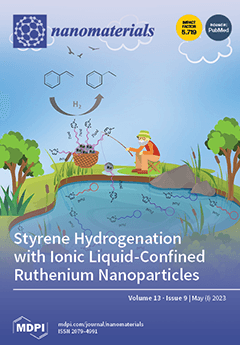One of the critical techniques for developing hydrogen storage applications is the advanced research to build novel two-dimensional materials with significant capacity and effective reversibility. In this work, we perform first-principles unbiased structure search simulations to find a novel AsC
monolayer with
[...] Read more.
One of the critical techniques for developing hydrogen storage applications is the advanced research to build novel two-dimensional materials with significant capacity and effective reversibility. In this work, we perform first-principles unbiased structure search simulations to find a novel AsC
monolayer with a variety of functionally advantageous characteristics. Based on theoretical simulations, the proposed AsC
has been found to be energetically, dynamically, and thermally stable, supporting the viability of experiment. Since the coupling between H
molecules and the AsC
monolayer is quite weak due to physisorption, it is crucial to be enhanced by thoughtful material design. Hydrogen storage capacity can be greatly enhanced by decorating the AsC
monolayer with Li atoms. Each Li atom on the AsC
substrate is shown to be capable of adsorbing up to four H
molecules with an advantageous average adsorption energy (E
) of 0.19 eV/H
. The gravimetric density for hydrogen storage adsorption with 16Li and 64 H
of a Li-decorated AsC
monolayer is about 9.7 wt%, which is helpful for the possible application in hydrogen storage. It is discovered that the desorption temperature (T
) is much greater than the hydrogen critical point. Therefore, such crucial characteristics make AsC
-Li be a promising candidate for the experimental setup of hydrogen storage.
Full article






